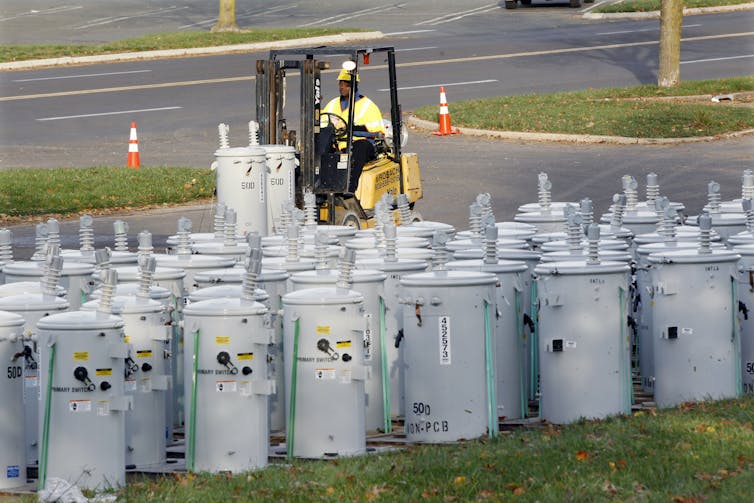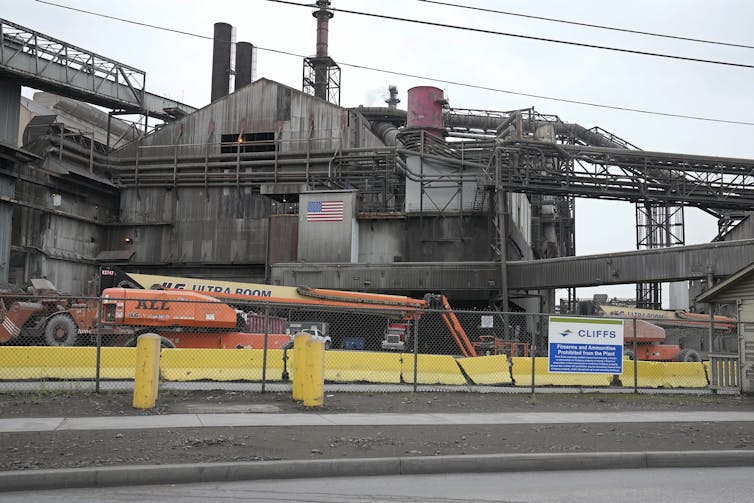Supply-chain delays, rising equipment prices threaten electricity grid
- Written by Morgan Bazilian, Professor of Public Policy and Director, Payne Institute, Colorado School of Mines
Two new data centers in Silicon Valley have been built but can’t begin processing information: The equipment that would supply them with electricity[1] isn’t available.
It’s just one example of a crisis facing the U.S. power grid that can’t be solved simply by building more power lines, approving new power generation, or changing out grid software. The equipment needed to keep the grid running – transformers that regulate voltage, circuit breakers that protect against faults, high-voltage cables that carry power across regions, and steel poles that hold the network together – is hard to make, and materials are limited. Supply-chain bottlenecks are taking years to clear, delaying projects, inflating costs and threatening reliability.
Meanwhile, U.S. electricity demand is surging from several sources – electrification[2] of home and business appliances and equipment, increased domestic manufacturing[3] and growth in AI data centers[4]. Without the right equipment, these efforts may take years longer and cost vast sums more than planners expect.
Not enough transformers to replace aging units
Transformers are key to the electricity grid: They regulate voltage as power travels across the wires, increasing voltage for more efficient long-distance transmission, and decreasing it for medium-distance travel and again for delivery to buildings.
The National Renewable Energy Laboratory[5] estimates that the U.S. has about 60 million to 80 million high-voltage distribution transformers in service. More than half of them are over 33 years old[6] – approaching or exceeding their expected lifespans.
Replacing them has become costly and time-consuming, with utilities reporting that transformers cost four to six times what they cost before 2022[7], in addition to the multiyear wait times.
To meet rising electricity demand, the country will need many more of them – perhaps twice as many as already exist[8].

The North American Electric Reliability Corporation[10] says the lead time, the wait between placing an order and the product being delivered, hit roughly 120 weeks – more than two years – in 2024, with large power transformers taking as long as 210 weeks – up to four years. Even smaller transformers used to reduce voltage for distribution to homes and businesses are back-ordered as much as two years[11]. Those delays have slowed both maintenance and new construction across much of the grid.
Transformer production depends heavily on a handful of materials and suppliers. The cores of most U.S transformers use grain-oriented electrical steel[12], a special type of steel with particular magnetic properties, which is made domestically only by Cleveland-Cliffs[13] at plants in Pennsylvania and Ohio. Imports have long filled the gap: Roughly 80% of large transformers[14] have historically been imported from Mexico, China and Thailand. But global demand has also surged[15], tightening access to steel, as well as copper, a soft metal that conducts electricity well and is crucial in wiring.
In partial recognition of these shortages, in April 2024, the U.S. Department of Energy delayed the enforcement of new energy-efficiency rules[16] for transformers, to avoid making the situation worse.
Further slowing progress, these items cannot be mass-produced. They must be designed, tested and certified individually[17].
Even when units are built, getting them to where they are needed can be a feat. Large power transformers often weigh between 100 tons and 400 tons and require specialized transport – sometimes needing one of only about 10 suitable super-heavy-load railcars[18] in the country. Those logistics alone can add months to a replacement project, according to the Department of Energy[19].

Other key equipment
Transformers are not the only grid machinery facing delays. A Duke University Nicholas Institute study, citing data from research and consulting firm Wood Mackenzie, shows that high-voltage circuit-breaker lead times[22] reached about 151 weeks – nearly three years – by late 2023, roughly double pre-pandemic norms.
Facing similar delays are a range of equipment types[23], such as transmission cables that can handle high voltages, switchgear – a technical category that includes switches, circuit breakers and fuses – and insulators to keep electricity from going where it would be dangerous.
For transmission projects, equipment delays can derail timelines. High-voltage direct-current cables now take more than 24 months to procure, and offshore wind projects are particularly strained: Orders for undersea cables can take more than a decade to fill[24]. And fewer than 50 cable-laying vessels[25] operate worldwide, limiting how quickly manufacturers can install them, even once they are manufactured.
Supply-chain strains are hitting even the workhorse of the power grid: natural gas turbines. Manufacturers including Siemens Energy and GE Vernova have multiyear backlogs as new data centers, industrial electrification and peaking-capacity projects[26] flood the order books. Siemens recently reported a record US$158 billion backlog[27], with some turbine frames sold out for as long as seven years.
 The Cleveland-Cliffs steelworks in Ohio makes a specialized type of steel that is crucial for making transformers.
AP Photo/Sue Ogrocki[28]
The Cleveland-Cliffs steelworks in Ohio makes a specialized type of steel that is crucial for making transformers.
AP Photo/Sue Ogrocki[28]
Alternate approaches
As a result of these delays, utility companies are finding other ways to meet demand, such as battery storage, actively managing electricity demand, upgrading existing equipment[29] to produce more power, or even reviving decommissioned generation sites.
Some utilities are stockpiling materials for their own use[30] or to sell to other companies, which can shrink delays from years to weeks.
There have been various other efforts, too. In addition to delaying transformer efficiency requirements[31], the Biden administration awarded Cleveland-Cliffs $500 million[32] to upgrade its electrical-steel plants – but key elements of that grant were canceled by the Trump administration.
Utilities and industry groups are exploring standardized designs and modular substations[33] to cut lead times – but acknowledge that those are medium-term fixes[34], not quick solutions.
Large government incentives, including grants, loans and guaranteed-purchase agreements, could help expand domestic production of these materials and supplies. But for now, the numbers remain stark: roughly 120 weeks for transformers, up to four years for large units, nearly three years for breakers and more than two years for high-voltage cable manufacturing. Until the underlying supply-chain choke points – steel, copper, insulation materials and heavy transport – expand meaningfully, utilities are managing reliability not through construction, but through choreography.
References
- ^ The equipment that would supply them with electricity (www.bloomberg.com)
- ^ electrification (www.energy.gov)
- ^ increased domestic manufacturing (www.csis.org)
- ^ growth in AI data centers (theconversation.com)
- ^ National Renewable Energy Laboratory (www.nrel.gov)
- ^ over 33 years old (www.nrel.gov)
- ^ four to six times what they cost before 2022 (www.woodmac.com)
- ^ perhaps twice as many as already exist (www.nrel.gov)
- ^ AP Photo/Mel Evans (newsroom.ap.org)
- ^ North American Electric Reliability Corporation (www.nerc.com)
- ^ back-ordered as much as two years (docs.nrel.gov)
- ^ grain-oriented electrical steel (www.thyssenkrupp-steel.com)
- ^ Cleveland-Cliffs (www.qualitrolcorp.com)
- ^ 80% of large transformers (www.woodmac.com)
- ^ global demand has also surged (www.woodmac.com)
- ^ delayed the enforcement of new energy-efficiency rules (www.nema.org)
- ^ designed, tested and certified individually (metapowersolutions.com)
- ^ super-heavy-load railcars (www.trains.com)
- ^ Department of Energy (www.energy.gov)
- ^ Raimond Spekking via Wikimedia Commons (commons.wikimedia.org)
- ^ CC BY-SA (creativecommons.org)
- ^ high-voltage circuit-breaker lead times (nicholasinstitute.duke.edu)
- ^ range of equipment types (www.nerc.com)
- ^ take more than a decade to fill (www.offshore-mag.com)
- ^ 50 cable-laying vessels (ig.ft.com)
- ^ new data centers, industrial electrification and peaking-capacity projects (www.nrucfc.coop)
- ^ US$158 billion backlog (finance.yahoo.com)
- ^ AP Photo/Sue Ogrocki (newsroom.ap.org)
- ^ upgrading existing equipment (www.gevernova.com)
- ^ stockpiling materials for their own use (www.energy.gov)
- ^ delaying transformer efficiency requirements (www.utilitydive.com)
- ^ Cleveland-Cliffs $500 million (www.journal-news.com)
- ^ exploring standardized designs and modular substations (www.bloomberg.com)
- ^ medium-term fixes (www.bloomberg.com)
Authors: Morgan Bazilian, Professor of Public Policy and Director, Payne Institute, Colorado School of Mines


